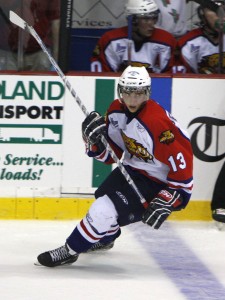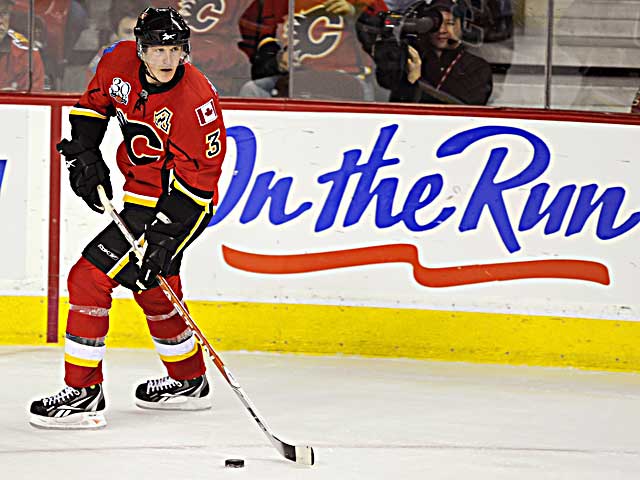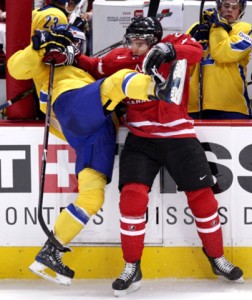Book Review: Gretzky’s Tears by Stephen Brunt
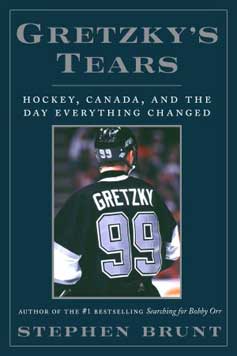 Gretzky’s Tears is the latest book by the Globe and Mail’s Stephen Brunt. It examines the controversial trade of Wayne Gretzky from the Oilers to the Los Angeles Kings, almost bringing an end to Edmonton’s Stanley Cup dynasty and launching the National Hockey League’s sputtering Sunbelt Expansion.
Gretzky’s Tears is the latest book by the Globe and Mail’s Stephen Brunt. It examines the controversial trade of Wayne Gretzky from the Oilers to the Los Angeles Kings, almost bringing an end to Edmonton’s Stanley Cup dynasty and launching the National Hockey League’s sputtering Sunbelt Expansion.
Brunt is one of Canada’s foremost sports journalists, and one of the best “big picture” writers in the newspaper business today. Unfortunately, Gretzky’s Tears does not meet Brunt’s usually high standards, particularly in contrast to his own body of work and other media on the subject.
The closest comparison is Brunt’s previous book, Searching for Bobby Orr, which I reviewed on my old blog . Indeed, in the Acknowledgements section of Gretzky’s Tears Brunt says that it was intended as a sequel to Searching.
Both books spotlight the greatest hockey player of their generation, both address the theme of innocence lost and both subjects shy away from the limelight. Orr was always intensely private and Gretzky is big on controlling his own public image.
As a result, Brunt was unable to interview either player for his books. Instead, he focuses on interviewing the people around Gretzky and Orr, painting a picture of the circumstances and personalities surrounding these prominent Canadian figures.
It was a very effective method in Searching for Bobby Orr, but falls flat in Gretzky’s Tears.
The difference is that Orr’s entourage has maintained an omerta-like silence around the former Boston Bruin. Even former business associates like Alan Eagleson and Harry Sinden, both of whom have fallen out with Orr, did not participate in Brunt’s research for Searching.
However, in Gretzky’s Tears, two of the principals in the trade, former Oilers owner Peter Pocklington and former Kings owner Bruce McNall, submitted to extensive interviews. The result comes across as a rather jaundiced account of the deal. Pocklington and McNall (and to a lesser extent former Edmonton General Manager Glen Sather) all get to say their piece, wheras Brunt, and therefore the reader, are left to guess at Gretzky’s state of mind before and after the move.
This would be fine if Gretzky’s Tears was created in a vacuum.
Unfortunately for Brunt, Pocklington wrote (with the help of Terry McConnell and J’Lyn Nye) a book of his own called I’d Trade Him Again that includes a forward by the Great One.
Worse yet, ESPN’s 30-for-30 documentary Kings Ransom also looks at the trade and filmmaker Peter Berg spoke extensively with Gretzky.
A smaller problem with the book is that it seems as though the editors backed off of Brunt’s copy. This might be because of the success of Searching for Bobby Orr, but Gretzky’s Tears suffers without a firm guiding hand.
The first chapter of Gretzky’s Tears is a ponderous exploration of loss of innocence that could have been cut completely. Further, Brunt has, for whatever reason, begun to copy sentences from one chapter to the next almost verbatim.
For example, towards the end of the book Brunt discusses Canada’s Olympic gold medal in 2002 and the rousing speech Greztky made at a press conference early in the games.
“[Gretzky] suggested that Canada was all alone, that the rest of Planet Hockey wanted it to fail, that it was us against the world. Standing in the room listening to him that day, it was difficult to tell how much was honest emotion, how much was a contrived attempt to inspire his team.” (p. 245)
Interesting commentary, except that just 45 pages earlier Brunt had described the same incident:
“Gretzky without prompting launched into a tirade – spontaneous or contrived – about how the whole hockey world wanted Canada to lose, it became a natural call to arms for both the country and the players.” (p. 200)
I only used excerpts, but aside from sentence structure the passages are almost identical.
It’s not an isolated incident either. There are several paragraphs throughout the book that repeat information and use similar phrasing. It’s a distracting habit and one that Brunt or his editor should have picked up on.
And that is the most disappointing thing about this book.
Stephen Brunt is an excellent writer who, in my opinion, is one of the best sports columnists in Canada. Searching for Bobby Orr was thoroughly researched and did a wonderful job of explaining the magic of Orr. On the other hand, Gretzky’s Tears is a flawed book that suffers by comparison to Brunt’s earlier work and the work of others.
By any other author this would be a solid book, but Brunt is a victim of his own success.
Phaneuf gets the headlines, but Giguere wins the games
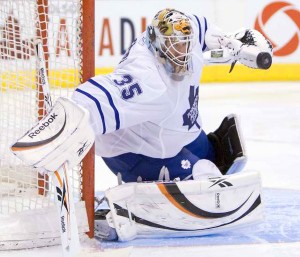 I was fortunate enough to attend the Maple Leafs game Tuesday night when Freddie Sjostrom, Dion Phaneuf and Jean-Sebastien Giguere debuted in Toronto’s 3-0 win over the New Jersey Devils.
I was fortunate enough to attend the Maple Leafs game Tuesday night when Freddie Sjostrom, Dion Phaneuf and Jean-Sebastien Giguere debuted in Toronto’s 3-0 win over the New Jersey Devils.
The buzz before the game centred around Phaneuf, but Giguere is going to be the difference maker on this team.
It was apparent after just one period of play. Giguere looked confident in the net, always sure of his decision making.
“Giguere was solid," said head coach Ron Wilson in a press conference after the game. "He’s very professional, incredible focus and concentration out there, that’s what I noticed about him,”
Unlike his predecessor Vesa Toskala or his back-up Jonas Gustavsson, when Giguere makes a save he doesn’t look uncomfortable with the puck. There’s no sense of panic when he has to make a play.
“When we’ve gotten that kind of goaltending we usually play pretty well,” said Wilson. “Everybody settles down, you’re not bobbling pucks as much.”
That staid approach has already affected his teammates. Toronto’s defence has rarely looked this disciplined. Their awareness of the play developing around them was visibly heightened.
The few times that Giguere gave up rebounds the Maple Leafs quickly recovered and cleared the puck out. Most notably, Christian Hanson snapped the puck out of the crease and past the blue-line in the second period after Giguere had made a stop.
“Our defence did a great job in front of him, clearing people and handling rebounds. It was nice that all these guys arrive and they immediately help you out,” said Wilson.
Giguere even helps Toronto on offence, with his superior puck-handling skills creating scoring chances. An outlet pass off the boards from the Quebecois goaltender almost made it 4-0 for the Leafs in the dying minutes of the game.
On the power play, Giguere helped the defence get the puck back into the offensive zone quickly. He made the team more effective in every aspect of the game.
Obviously, Phaneuf made a difference as well.
“Dion got a couple of good hits in early,” said Wilson. “Every time he steps on the ice the other team is looking before they even attempt anything.”
Phaneuf certainly delighted Toronto’s fans by fighting Colin White, but it was Giguere who stole the show, and will continue to be the difference maker for the club.
A 3-0 win is a welcome sight on any team’s record, but this game in particular bodes well for Toronto’s future. Looking at Giguere's sterling stats Tuesday night is all the evidence needed to see that he is the one that will win the Maple Leafs games.
Toronto Maple Leafs take a big step forward by adding Phaneuf and Giguere
As everyone in the hockey world has heard, Brian Burke completed two massive trades Sunday with the Calgary Flames and Anaheim Ducks. Dion Phaneuf and Jean-Sebastien Giguere are the biggest acquisitions made by a Leafs team that looks drastically different from the version that took the ice against the New Jersey Devils Saturday night.
Both trades are intriguing, re-arranging Toronto’s salary cap and improving the Maple Leafs on-ice product in three major ways.
1. Dion Phaneuf adds depth to the Leafs’ blue-line.
Phaneuf was the best player involved in the trade with Calgary. I know it’s a saying that’s been repeated a lot in the wake of these deals, but that doesn’t make it untrue. On paper, Toronto has a fantastic defensive corps with Tomas Kaberle, Francois Beauchemin, Mike Komisarek, Luke Schenn, Carl Gunnarson and now Phaneuf.
The 6’3, 214 pound native of Edmonton will be the kind of physical presence that the Leafs are trying to trademark. Phaneuf will also help Toronto flesh out its power play. Best of all, he’s just 24, meaning he’s got at least a decade left in his career. Definitely a win for Burke.
2. Getting rid of Jason Blake’s outrageously bad shot selection.
Most people have focused on dropping Blake’s 4.5 million per season, but coach Ron Wilson must be thrilled to have the phrases “Blake takes a wristshot from the faceoff circle” and “Blake with the wrap-around attempt” removed from Toronto’s television broadcasts.
The statistics are telling: in the past three years he’s taken 804 shots on goal, scoring 50 times. That’s a 6.2% success rate, folks. Put another way, in his time with the Leafs Blake averaged nearly 4 shots a game, but put the puck in the back of the net once every four games. Think of all the turnovers in that other 75% of games where he was off the mark. If that’s not addition by subtraction, I don't know what is.
3. Jean-Sebastien Giguere is a big improvement over Vesa Toskala.
Giguere has been to the Stanley Cup final twice and won the whole thing a couple of years ago. Although he’s struggled of late, reuniting with goalie coach Francois Allaire should put him on the right path again. In any event, Giggy can definitely be a starting goaltender and also mentor Jonas Gustavsson.
And, you know, it’s best to move on from this beauty:
The one drawback of these deals is the departure of Niklas Hagman, who was Toronto’s best two-way forward. He was the team’s most consistent scorer and always showed a lot of grit on the ice.
However, the good far outweighs the bad for the Toronto Maple Leafs on these trades, and Burke has made some serious moves that will improve Toronto next season without giving up any draft picks, prospects or cap space. Sunday was definitely a banner day in Leafs nation.
Toronto Maple Leafs make huge changes
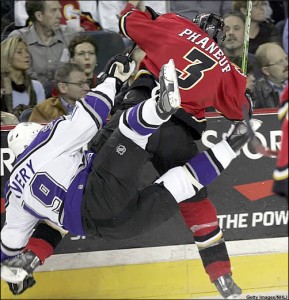 It's come out today that Toronto Maple Leafs General Manager Brian Burke has shaken up his team, making two big trades.
It's come out today that Toronto Maple Leafs General Manager Brian Burke has shaken up his team, making two big trades.
First, he sent Slovenian heart-throb Matt Stajan, Ian White, Jamal Mayers and Niklas Hagman to the Calgary Flames for Dion Phaneuf, Fredrik Sjostrom and Keith Aulie.
Then, he sent Vesa Toskala and Jason "Johnny Wristshot" Blake to the Anaheim Ducks for J-S Giguere.
I've got to head off to work shortly, so extensive commentary will have to wait until tomorrow. Right now, it's hard to tell if the Leafs are better or worse, but they are certainly different.
Cormier changes his mind; appeals QMJHL suspension
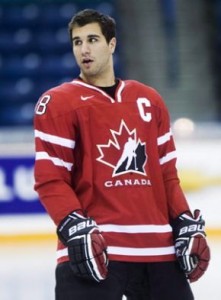 Patrice Cormier has had a change of heart, and all it’s going to cost him is what little credibility he has left.
Patrice Cormier has had a change of heart, and all it’s going to cost him is what little credibility he has left.
The Rouyn-Noranda Huskies and Cormier announced yesterday that they would be appealing the Quebec Major Junior Hockey League’s season-long suspension of the 19-year-old forward.
“He could serve up to 48 games, that's too much,” said Huskies coach and general manager Andre Tourigny.
“I respect the decision of the QMJHL even if I find it too severe. I deeply regret the circumstances surrounding this event and I wish Mikael Tam a speedy and full recovery. Thanks for your attention,” said Cormier in a short statement read to the Canadian Press by telephone.
This is a departure from his statement Tuesday morning: “I fully respect the Quebec Major Junior League's decision regarding the Mikael Tam incident.”
Earlier this week I had criticized that particular statement by Cormier because there was no actual apology to Tam. He still hasn’t apologized and this appeal is much worse, adding insult to injury.
Cormier could have continued his career in, as Tourigny said, just 48 games. If he had accepted his punishment, acted contrite whenever asked about the incident and worked hard on the ice to develop as a player, he’d likely make the NHL within two years.
But now he’s rubbing some salt in the wound, and not winning over any supporters.
Although I felt that the suspension was a fair punishment for what was clearly a malicious hit, other corners were calling for a lifetime ban. I can only imagine the ink that will be spilled if Cormier’s suspension is shortened.
That said, I do understand the team’s motivation behind the appeal. Rouyn-Noranda paid a hefty price to acquire Cormier. Specifically, they sent two promising players in Michael Beaudry and Alexandre Mallet (both just 18 years old) as well as three first round draft picks and one second round draft pick to the Rimouski Oceanic for Cormier and Jordan Caron.
To lose one of those players to suspension for the rest of the season – and possibly for the rest of his junior career if he moves on to the NHL or AHL next year – cripples the Huskies playoff chances. Rouyn-Noranda’s playoff window is closing, and Tourigny knows that he gave up the team’s future is bleak without those four picks.
The problem is, of course, that although Cormier might not play again this season, he’ll definitely be playing somewhere next year. The same can’t be said for his victim, Mikael Tam.
Although Cormier’s suspension is a bitter pill to swallow, it did give him the opportunity to move on. The same can’t be said for Tam. Cormier should be counting his blessings, not the number of games he’ll be missing.
Cormier’s suspension should start a discussion about changing hockey’s culture
The Quebec Major Junior Hockey League has suspended forward Patrice Cormierof the Rouyn-Noranda Huskies for the rest of the regular season and the playoffs.
Of course they did. Really, it’s the only option the league’s disciplinarian had after the former captain of Canada’s World Junior tournament team laid Mikael Tamof the Quebec Remparts out with a vicious elbow.
But there are still lots of questions, the biggest and broadest of which is: where do we go from here? Not just Tam and Cormier, but the game itself.
By all accounts, Tam has already begun to recover. He hasn’t shown any signs of a concussion and he’s been released from the hospital. All good news, to be sure. But no one is sure if he’ll be able to re-join his teammates, or when. Sad when you consider that the 18-year-old defenceman was having a career season with 10 goals and 12 assists.
Cormier, of course, will be spending most of his time training on his own. Lou Lamoriello, the GM of the New Jersey Devils who drafted Cormier 54th overall in the 2008 draft, has already stated that the team will not place him in the American Hockey League or on any other teams affiliated with the Devils.
"We will honour the league's suspension, have not considered, and will not explore other avenues for his return this season," Lamoriello said in a press release.
This won’t be the end of Cormier’s career though. He's still a top-flight prospect who might be able to bounce back from this incident. Certainly, if he keeps his head down, his nose clean and continues to develop as a player, the Devils will have to consider calling him up to the NHL in the next few seasons.
Cormier has issued his own public statement, saying, in part, “I deeply regret the circumstances surrounding this event and wish Mikael Tam a speedy and full recovery."
No apology to Tam, just some best wishes. As so often happens in incidents like this, the injured party has to deal with the consequences of the play, while the offender is able to, eventually, resume their career. I wouldn’t want Cormier on my team, but the world of hockey has found roomin its heart to forgive a lot of players after similarly vicious incidents. Todd Bertuzzi is the first name that comes to mind.
And that brings us to the real problem: violence in hockey.
After all, everyone abhors Cormier’s cheap shot, but no one knows how to remove dirty hits from the game. I know that I enjoy watching a good hockey fight, as I think most people do, and there’s nothing like a good, solid hit. Hockey is an intrinsically violent game.
But there is a semi-permanent, translucent line in hockey that a player can cross where finishing their check somehow becomes a late hit. Standards seem to change case by case. This line needs to be better defined, with clearer consequences outlined. How else can hockey separate good violence from, for lack of a better term, bad violence?
I’m not sure. Hockey and hockey culture will always be physical, and tough players will always be admired. It would require an incredible sea-change to adjust the attitudes of players, coaches, officials and fans.
Suspending Cormier is certainly a good step. He’s a very visible junior hockey player, and as I mentioned in an article last week, he’s a repeat offender. It sends a strong message to the hockey community, and was the natural conclusion to a nasty chapter in QMJHL history.
Forcing Cormier, and other offenders at all levels of hockey, to engage in public awareness campaigns might be productive as well.
However, the most effective solution would be to force the offending player’s team to forfeit the game.
Had Quebec lost that game (the Remparts rallied to win 3-2 in the shootout), I feel that the QMJHL should have ruled the game as a forfeit for Rouyn-Noranda. If this became standard practice in junior and professional hockey leagues, I think it would create a sense of peer pressure that a cheap or dirty hit hurts the team in the standings, and players and coaches would do a better job of policing themselves. After all, no one wants to be directly responsible for costing their team a game, in addition to be suspended and fined.
It will take a huge, systemic change to eliminate dirty hits from hockey, but I think it’s time that better minds than mine began to apply themselves to this problem.
Entrance video for the University of Alaska Fairbanks hockey team
This isn't news, or a feature. It's just a fun video that I saw on Twitter thanks to EugePYDK, better known as Eugene Ahn, the co-host of War Rocket Ajax, the writer of Self-Titled Eponymous, the rapper Adam Warrock, the Fake AP Stylebook and just generally a busy guy.
It's nice to see a hockey video causing so much excitement... and hey, it does so without depicting a vicious elbow to the head.
Enjoy.
Phil Kessel cost the Leafs too much
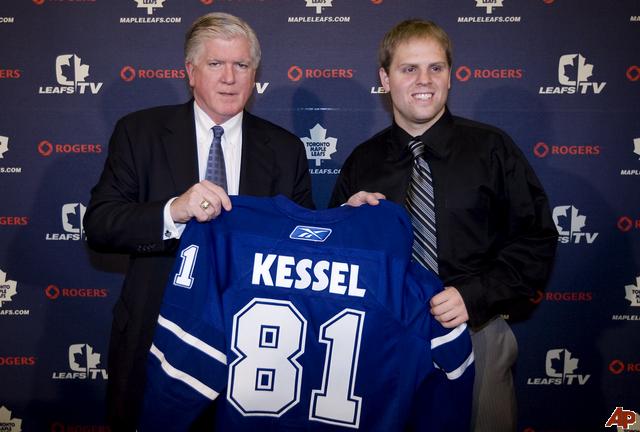 The Toronto Maple Leafs edged the Nashville Predators 4-3 Monday night, getting a late game-winning goal from young Phil Kessel, Brian Burke’s shiny acquisition, the cornerstone of the Age of Truculence.
The Toronto Maple Leafs edged the Nashville Predators 4-3 Monday night, getting a late game-winning goal from young Phil Kessel, Brian Burke’s shiny acquisition, the cornerstone of the Age of Truculence.
Since he started playing for the Leafs (about six weeks after the trade that brought him to Toronto from Boston) he has scored 15 goals and 13 assists, and is easily the best player on the Leafs.
But I think the trade has been a terrible mistake. He doesn’t have enough help on the ice, he’s not a franchise player, and ultimately, the price was too high for Toronto.
Don’t get me wrong, he is a great player. He finds open space, sees plays developing and makes intelligent decisions with the puck. He can score from anywhere in the offensive zone and demands that the other team cover him tightly, giving his teammates room to breathe.
Unfortunately, his teammates don’t seem to know what to do with that space. As a result, opposing defences have begun to take advantage of the Leafs lack of depth. They have, as defensive coaches say, begun to cheat on Kessel.
Defensive strategy relies heavily on reactive responses to an offence. Obviously, a good defence reacts to where the puck is, where the players are. But because Toronto does not have a strong secondary scoring threat, defences have taken to sealing off Kessel as soon as he’s on the ice. They know that should he pass the puck, the Leafs probably aren’t going to be able to score.
Now, there are some players who would be able to overcome that, who could make the players around them better. The kind of players that only need to be identified by their surnames: Gretzky, Lemieux, Crosby, Ovechkin, Brodeur, Roy. Unfortunately, Kessel just doesn’t belong there. He’s a very good hockey player, but his shoulders aren’t broad enough to carry an entire franchise.
And that, ultimately, is why trading two first round picks and a second round pick was too much for Kessel.
That’s an awfully high price, jeopardizing the Leafs for the next five or more years. Frankly, I’m not sure that I’d trade that much for any of the franchise players mentioned above, let alone Phil Kessel.
With the Leafs toiling near the bottom of the standings, the trade looks even worse. There’s a good chance that the division rival Boston Bruins landed themselves a top three pick that could mean Taylor Hall or Tyler Seguin, both quality players that would’ve helped the Leafs considerably, and at the rookie maximum salary instead of Kessel’s $27 million over five years.
When there were rumours that Toronto was going to trade with the Boston Bruins, that Burke might land Kessel, a proven sniper, I was ecstatic. At last, the Leafs were going to start to turn it around. Most people I knew thought that too, but my good friend Ruben and my dad both held out, saying that it was a bad trade. It took me a while, but now I see it too. Phil Kessel is a quality player, but the price the Maple Leafs paid was way too high.
The Quebec Major Junior Hockey League is definitely not soft
This video has been making the rounds Monday morning, and it’s pretty tough to watch.
At about the one-minute mark Team Canada’s world junior captain Patrice Cormier comes off the Rouyn-Noranda bench, skates through centre ice and lays out Quebec’s Mikael Tam with a vicious elbow to the head.
Ironically, of the three leagues that comprise the Canadian Hockey League, it’s the Q that has a reputation of a softer, finesse style of play that emphasizes goaltending and skilled scorers. The events of this weekend underscored the fact that this really is not the case.
According to TSN.ca: “Following the hit, Tam was convulsing on the ice before being taken off on a stretcher. Tam suffered trauma to the skull and brain and lost many teeth. He is now in stable condition in hospital and will remain under observation for at least two days.”
Although I followed the results of that game, the summary really didn’t do justice to the viciousness of that hit. After all, "Penalties: ROU - Patrice Cormier (03:32)(maj.), ROU - Patrice Cormier (03:32)(match)" isn't much of a story.
As TSN’s Bob McKenzie tweeted: “This Cormier elbow is sickening on so many levels. I have never been so discouraged about the game of hockey as now.”
The QMJHL’s Disciplinary Prefect, Raymond Bolduc, is currently investigating the incident, and the league will take action in the next day or two. I expect that Cormier is looking at some lengthy time away from the ice.
Watching the Tam video is reminiscent of Cormier’s hit in a preliminary World Junior Championship match against Sweden where he hit Sweden's Anton Rodin with an elbow and bloodied his nose.
I thought Cormier took unnecessary penalties throughout the WJC tournament, and his actions definitely hurt Team Canada’s performance in the playoff rounds.
Also on Sunday, Bolduc suspended Tommy Tremblay of the Shawinigan Cataractes for four games. Bolduc found that Tremblay had been the aggressor in a fight with the Victoriaville Tigers’ Guillaume Goulet.
The left-winger earned two game misconducts during the game, and the league tacked on another two after reviewing videotape of the incident on Saturday. Additionally, the Cataractes were fined $500.
I follow the QMJHL pretty closely, in fact, it’s my favourite junior hockey league. Although it’s not nearly as rough and tumble as the Western Hockey League, I think its physicality is under-rated.
Although line brawls (like the one that happened between the Vancouver Giants and Prince George Cougars Saturday night) are rare in Quebec, the QMJHL has its fair share of truculence.
